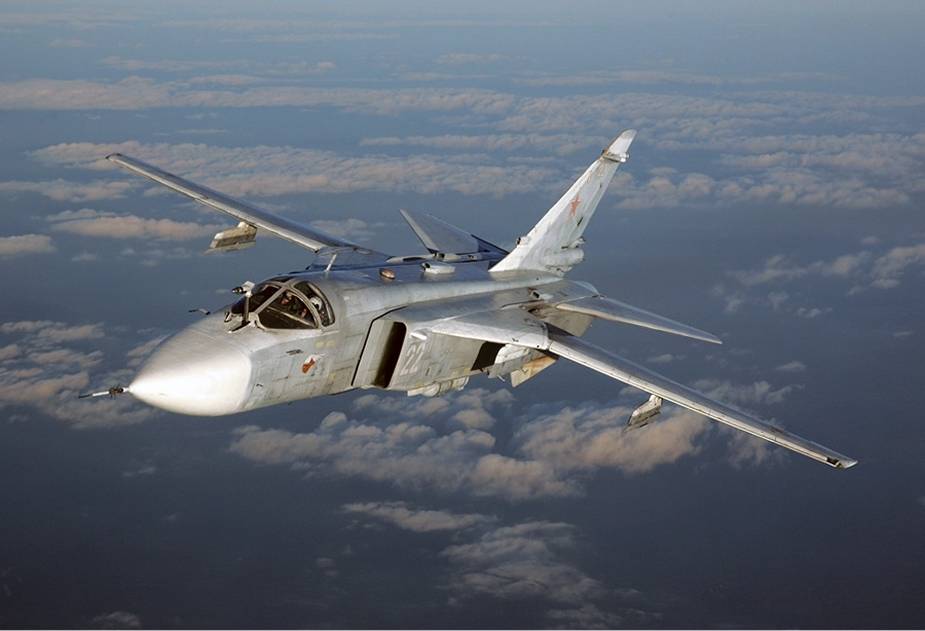Russia is completing the creation of the backbone of Arctic airpower. New airplanes and helicopters will be delivered in 2021, and garrison command system formed. Infrastructure and forces have been built up in the Arctic of late. For the first time in modern history, one country succeeded to deploy airpower in the region. The Izvestia daily writes about the Arctic airpower and its missions.
Follow Air Recognition on Google News at this link
 Sukhoi Su-24M (Picture source: Wikimedia/Dmitriy Pichugin)
Sukhoi Su-24M (Picture source: Wikimedia/Dmitriy Pichugin)
The backbone of the Russian Arctic airpower has to be created by late 2020, Defense Ministry sources said. Besides hardware supplies, the command system of air units and garrisons will be changed and an effective communication network deployed. Two formations are currently in charge of Arctic defense : the NorthernFfleet is in charge of the western and central sections. The Northeastern Command is in charge of the northeast and Bering Strait. Both formations possess impressive naval aviation.
The Northern fleet has the 45th Air Force and defense army. The air component includes the 100th and 279th Naval Air Regiments armed with MiG-29K/KUB and Su-33 jets respectively.
The 403rd combined regiment is in charge of rescue and antisubmarine operations, as well as reconnaissance. It operates antisubmarine Tu-142M, Il-38 and Il-38N, as well as An-12, An-26 and specialized Il-18 aircraft. They are deployed close to the main base in Severomorsk. A Tu-142M squadron is deployed in Kipelovo settlement in Vologda region. It covers a space up to the Arctic Ocean and flies over the North Atlantic.
The 98th Combined Air Regiment is deployed in Monchegorsk and is armed with frontline Su-24M bombers and MiG-31 fighter jets. It has to support surface operations in the Barents Sea and air defense missions. The operation of various jets by one regiment causes problems. The expanded supplies of upgraded MiG-31BM are likely to deploy a fighter jet regiment there.
The 830th regiment is the helicopter component of the 45th Army. It operates various Ka-27, including upgraded Ka-27M and combat-transport Ka-29. The Northern Fleet also has the only drone regiment in the armed forces.
The Northeastern forces have the 317th Regiment with antisubmarine Il-38 and Il-38N aircraft, airlifters, MiG-31 fighter jets, various helicopters and drones. The regiment is likely to deploy several separate formations, e.g. a MiG-31BM fighter jet, helicopter, and drone regiments. A squadron of Tu-142M3 aircraft is based near the seaport of Sovetskaya Gavan. Aircraft and helicopters of the Aerospace Forces, including Mi-26, can be engaged for airlifting purposes.
The immense space of the Arctic Ocean, the climate change and melting ice made it possible for foreign vessels to sail in the Arctic waters in summertime without any control. Therefore, the naval aviation badly needs modern patrol aircraft and long-range drones.
The naval aviation operates Il-38 and Tu-142. The Soviet-built aircraft are being upgraded, but the fleet needs a new patrol aircraft which can be developed from a passenger plane according to the global trend. It provides much space for equipment and decreases flight costs.
Long-range drones are necessary, but Russia unfortunately lags behind other countries in their creation. However, positive shifts have emerged. Orion drone has been supplied.
The squadrons of the 98th and 317th Regiments are rearmed with MiG-31BM and the naval aviation masters new techniques of their engagement.
The naval airlifting component also needs to be developed. Military bases have been reopened in Franz-Joseph, Kotelny, Wrangel and other islands of late. Airplanes and helicopters of the Aerospace Forces are used to supply them. However, Mi-26 helicopter flights from Khabarovsk to Wrangel Island are not rational.
The naval aviation can engage in a broad range of Arctic missions. However, it badly needs new patrol aircraft and long-range drones, the Izvestia wrote.
© Copyright 2020 TASS. All rights reserved. This material may not be published, broadcast, rewritten or redistributed.
















